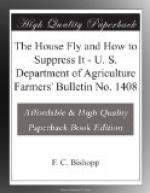KINDS OF FLIES FOUND IN HOUSES.
Several species of flies are found commonly in houses. Some of them so closely resemble the true house fly that it requires very careful observation to distinguish them from it.
One of these is the biting stable fly[2] (fig. 1). It occurs frequently in houses and differs from the house fly in the important particular that its mouth parts are formed for piercing the skin. This fly is so often mistaken for the house fly that most people think that the house fly can bite.
Another frequent visitant of houses, particularly in the spring and fall, is the cluster fly.[3] It is somewhat larger than the house fly, and is distinguished by its covering of fine yellowish hairs. Occasionally this fly occurs in houses in such numbers as to cause great annoyance. It gets its name of “cluster fly” from its habit of collecting in compact groups or clusters in protected corners during cold periods.
Several species of metallic greenish or bluish flies also are found occasionally in houses. These include a blue-bottle fly,[4] the black blowflies,[5] and the green-bottle (fig. 2) flies.[6] They breed in decaying animal matter.
[Footnote 1: Musca domestica L.] [Footnote 2: Stomoxys calcitrans L.] [Footnote 3: Pollenia rudis Fab.] [Footnote 4: Calliphora erythrocephala Meig.] [Footnote 5: Phormia regina Meig. and P. terrae-novae Desv.] [Footnote 6: Lucilia caesar L., L. sericata Meig., and other species of the genus.]
There is still another species, smaller than any of those so far mentioned, which is sometimes called the “lesser house fly."[7] This insect is distinguished from the ordinary house fly by its paler and more pointed body. The male, which is commoner than the female, has large pale patches at the base of the abdomen, which are translucent when the fly is seen on the window pane. These little flies are not the young of the larger flies. Flies do not grow after the wings have once expanded and dried.
[Footnote 7: Fannia canicularis L.]
[Illustration: FIG. 1.—The stable fly. Much enlarged.]
[Illustration: FIG. 2.—One of the green-bottle flies (Lucilia caesar). Much enlarged.]
In late summer and autumn many specimens of a small fruit fly, known as the “vinegar fly,"[8] make their appearance, attracted by the odor of overripe fruit.
All of these species, however, are greatly dwarfed in numbers by the common house fly. In 1900 the senior author made collections of the flies in dining rooms in different parts of the country, and found that the true house fly made up 98.8 per cent of the whole number captured. The remainder comprised various species, including those mentioned above.
[Footnote 8: Drosophila ampelophila Loew.]
[Illustration: Fig. 3.—The true house fly. Enlarged.]




